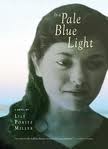 Libka Hoffman was born in Cape Town, South Africa soon after her Jewish parents emigrated there from Lithuania about 1930. But Libka — the protagonist of In A Pale Blue Light, an extraordinary first novel by Toronto writer Lily Poritz Miller — is radically at odds with her society.
Libka Hoffman was born in Cape Town, South Africa soon after her Jewish parents emigrated there from Lithuania about 1930. But Libka — the protagonist of In A Pale Blue Light, an extraordinary first novel by Toronto writer Lily Poritz Miller — is radically at odds with her society.
As she enters her teenage years in the 1940s, Libka realizes she cannot live in a country in which coloured people are treated as inferiors and interracial fraternization is a strong social taboo. Her innocent friendships mark her as a social outcast.
In A Pale Blue Light opens a rare window onto life in South Africa’s apartheid society from a Jewish vantage point. Although the country offers the Hoffmans a safe haven from the Nazis and a chance to thrive in business, it is still a poisonous and dangerous place.
As the Hoffmans anxiously await letters from their relatives who didn’t get out of Europe in time, some Afrikaaners threaten them and break their windows with stones. Without quite realizing it, the family has jumped from a fire into a frying-pan, so to speak, finding themselves a vulnerable and barely tolerated minority in a country sizzling with antisemitic and xenophobic resentments.
Plunged into mourning by the death of her father, Libka is ridiculed by her schoolmates for performing tasks like scrubbing floors, considered menial for whites, and for her attachment to the family’s prized black servant, Maputo. Daily cloistering herself into a lavatory cubicle over the school lunch hour only adds to her reputation as a weird loner whose values bear close scrutiny.
A series of dark twists reveals the prejudiced and paranoid flavour of South African society. The family discharges Maputo under suspicion of theft and takes in an Afrikaan boarder who, it soon emerges, hates Jews. When he becomes violent, the wronged Maputo reappears like a guardian angel to protect the family. But the Afrikanaan boarder easily convinces the police to arrest Maputo and he is imprisoned, possibly for life.
As if she hadn’t learned her lesson, the defiant Libka later writes a letter to a Malayan boy she met on a beach. In a chillingly Kafkaesque passage that reveals the totalitarian nature of the racist regime, the headmistress of her correctional school intercepts his return letter and summons Libka to the office “on a most unsavoury matter.” An inquisition ensues in which the young girl is accused of attempting to subvert the country’s basic values.
Sara Hoffman, Libka’s mother, is a struggling immigrant with poor language skills and an equally poor understanding of what is happening around her; she is easily led and a willing victim for events about to occur. Blinkered in a different way, Libka’s brother Beryl wants only to fit in with his country-club friends and impress his girlfriend. He blames Libka for bringing shame to the family.
Although a haunting and ominous feeling dominates the prose, there are also occasional glimmers of light and sweetness. At moments In A Pale Blue Light seems reminiscent of To Kill A Mockingbird, whose wronged and martyred Tom Robinson character shares qualities with Maputo. The themes of prejudice, cruelty and injustice also bring to mind novels such as Disgrace and Cry the Beloved Country. Stephen King fans may also discern a slight affinity with Carrie, another female coming-of-age tale that features an overwhelming sense of ridicule and ostracism.
In A Pale Blue Light joins a long and respectable list of Canadian novels set in distant lands with little or no reference to Canada. Poritz Miller was born in Cape Town to Lithuanian parents, and came to the United States with her family when she was fifteen. She subsequently worked as an editor in the top echelons of the literary publishing business, both in New York and Toronto.
In A Pale Blue Light illuminates the Jewish experience in South Africa from the inside. Its language is original and its voice authentic and devoid of gimmickry. It is a mature and significant work that is bound to garner much attention and possibly literary awards as well. The book is forthcoming from the Sumach Press (sumachpress.com) in October 2009.♦
© 2009






